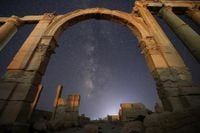In the heart of the Syrian desert, the ancient city of Palmyra stands as a testament to both the grandeur of human achievement and the resilience of cultural heritage. On August 29, 2025, visitors to this storied landscape are greeted by stately remnants of 2,000-year-old columns and temples, rising solemnly from the sand. Known locally as the "Bride of the Desert," Palmyra’s ruins shimmer beneath the relentless Middle Eastern sun by day and, come nightfall, are cast in silhouette beneath a sky crowded with countless stars—much as they did when the city first flourished centuries ago.
Palmyra's story is one of splendor, tragedy, and enduring hope. Once the glittering capital of a Roman client state under the formidable Queen Zenobia, the city was a linchpin of the Silk Road, the ancient trade route that stitched together Rome and Asia. According to the Associated Press, Palmyra’s strategic location made it a bustling hub where merchants, scholars, and adventurers from distant lands exchanged goods, ideas, and stories. The city's prosperity was mirrored in its grand architecture: soaring colonnades, intricate temples, and monumental arches that spoke of ambition and artistry.
But Palmyra’s fortune has always been tied to the tides of history. As the centuries rolled on, empires rose and fell, and the city’s fortunes waxed and waned. Yet, even after the passage of two millennia, the remnants of its glory refused to be swallowed by the desert. Locals, who have always known the city as the "Bride of the Desert," watched as Palmyra’s ruins became a symbol of Syrian identity and pride, eventually earning recognition as a UNESCO World Heritage site.
However, the 21st century brought new perils. Syria’s civil war, which erupted in 2011, cast a long shadow over the nation’s cultural treasures. According to AP reports, Palmyra was ravaged during the conflict, its ancient stones caught in the crossfire of a brutal struggle. The situation worsened dramatically when militants from the Islamic State group swept through the region. The world watched in horror as news broke of deliberate acts of destruction—temples, arches, and statues painstakingly built by ancient hands were reduced to rubble in mere moments.
Despite the devastation, Palmyra has endured. The city’s battered columns and half-toppled temples still rise defiantly from the sand, a silent rebuke to those who sought to erase its memory. As reported by the Associated Press, the ruins continue to draw the curious and the reverent alike, their silhouettes etched against the night sky as they have been for generations. The stars above Palmyra, unchanged for millennia, bear witness to the city’s long and tumultuous journey.
To understand Palmyra’s significance, it’s worth reflecting on its storied past. Queen Zenobia, who ruled in the third century AD, is remembered as one of history’s most remarkable female leaders. Her reign saw Palmyra reach its zenith, challenging Roman authority and briefly carving out an empire that stretched from Egypt to Anatolia. Zenobia’s legacy is still palpable among the ruins; her ambition and vision echo in the stones and the stories that locals share with visitors.
The city’s role as a Silk Road hub cannot be overstated. At its height, Palmyra was a melting pot of cultures, where caravans laden with silk, spices, and precious stones paused to rest and trade. Greek, Roman, Persian, and local influences blended seamlessly in the city’s art and architecture, making Palmyra a true crossroads of civilization. UNESCO’s recognition of the site underscores its global importance, not only as a relic of the past but as a beacon of cultural exchange and coexistence.
Yet, the scars of recent conflict remain visible. The civil war left its mark—not just on the stones, but on the people who call the region home. The destruction wrought by the Islamic State group was particularly heartbreaking. As the AP recounts, militants targeted some of Palmyra’s most iconic structures, including the Temple of Bel and the Arch of Triumph, in acts that drew international condemnation. The world’s archaeologists, historians, and ordinary citizens mourned the loss, recognizing that the damage was not merely physical but cultural—a wound to humanity’s shared heritage.
But amid the ruins, there is resilience. Efforts to restore and preserve Palmyra are ongoing, albeit hampered by the continuing instability in the region. Local communities, international organizations, and Syrian authorities have all expressed a commitment to safeguarding what remains. The hope is that, in time, Palmyra can once again become a place of learning, wonder, and connection—a bridge between past and present, East and West.
For now, the city endures, its battered stones standing as both a warning and an inspiration. The sight of Palmyra at night, its ruins outlined against a canvas of stars, is a reminder that beauty and meaning can survive even the darkest times. The "Bride of the Desert" may be battered, but she is not broken. Her story continues to unfold, inviting the world to remember, to mourn, and—most importantly—to hope.
In the end, Palmyra’s legacy is not simply about what has been lost, but about what endures. The city’s ancient columns and temples, though scarred, remain a powerful symbol of the resilience of culture and the enduring spirit of a people determined to protect their heritage for generations to come.






